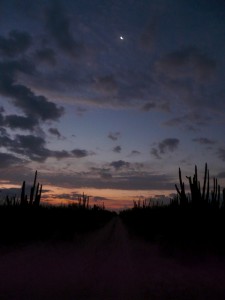
Sunrise on the Navopatia CBC
On December 27th Mario, Richard, Renner and myself left Alamos for the coastal village of Navopatia at around 2pm, it was a slightly overcast day and the forecast for the 28th, the count day was for rain. It was a beautiful drive down the back highway through Masiaca to highway 15. Adam met us at the turn to Navopatia because we needed to go in a different way due to the big irrigation water washouts on the regualr route in. We didn;t stop to bird on the way in mostly becasue I wanted to get to the field station before it got dark, getting oriented to the Navopatia camp is always more fun and impressive in the daylight. Even with the detour we still had to cross a couple of very ugly looking irrigation spill overs, including one that I doubt I would have attempted if I hadn't seen Adam make it through ahead of me! As Renner said after we got though it, "I want it to be known that water indeed passed over the hood of the van!". One of the big benefits of going this new way was that you don't have to look at nearly as much bulldozed cactus forest, although it is probably only a matter of time before they get to this nice forest as well. We rolled into the Navopatia Field station in tme to enjoy one of the amazing Sea of Cortez sunsets and to pick up a few birds in the small lagoon right in front of the station.
For me it was great to get back to Navopatia, it had been way too long since I had been there, maybe two years. The improvements that Adam and Sallie have done to the station are impressive! I had no idea how many little casitas that they had and how nice they are! Simple but very comfortable, obviously a lot of care went into building and appointing them.
After a bit of birding on the beach but mostly watching the incredible sunset and the Bottle-nosed Dolphins pass by, we headed up
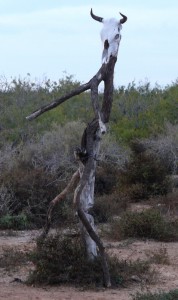
One of the cool sculptures at the Rancho
to the main Palapa for dinner. Adam had said not to worry about bringing dinner, or any food for that matter, they had it all under control. I never questioned that, but what we got was so over the top that i felt embarrased for even bringing a granola bar! Lupita is the camp cook and she has been at the station for a long time, even before Adam and Sallie knew it was there. Maybe they eat like that every night , but I doubut it. Tonights menu included fresh caught Mullet from the bay in front of the camp, fried and serve up with homemade blue corn tortillas with all the trimings for fish tacos. Desert consisted of two chocolate cakes cooked in the solar oven, absolutely awesome. The great food paired with good conversation made for a very enjoyable and memorable evening.
We were up at 5:30 and wanedering around in the dark deciding on who would ride with who and looking for a cup of coffee. Patrick was good enough to get up even earlier and get the Joe on and it was REALLY GOOD! Luptia had made up about a hundred Machaca and Bean tacos for us to take out on the count and we loaded them and all are stuff into the vans and were off on to the Monte and looking for birds.
This CBC was a bit unorthodox in the sense that we really only had two groups of coverage and one of them was rather large, I suppose that if we had split up we could have gotten some more birds, but Adams opinion is that CBC;s are to be fun and going as a group was a lot of fun! Plus we were a little short on vehicles and only a couple of us really knew how to get around the laberinth of roads and it is easy to get lost. I suppose for future counts it would be good to have at least a basic map for people to navigate, because more people will come one day!
Our first stop was for Elf owls in the Pitayal, the intensely dense Organpipe Cactus forest. Adam had explained to us the previous night that the stretch of cactus forest that we were birding in had the highest density of columar cactus of any cactus forest in the world! Being there in the middle of it at sunrise made it hard not to realize that this was true.
No Elf owl but we were off to the "Rancho" and its large lagoon and huge fig tree. It was pretty good around the lagoon, Kiskadees
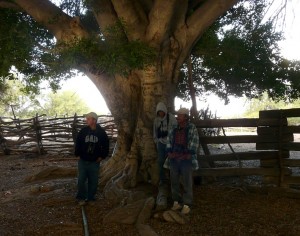
Mario, Lupito and Tino under the fig at the Rancho
and Social flycatchers were common and Mario and I had a great hour or so wandering around in the cactus forest. We found a lot of birds, a lot of them Gambell's Quail, which was a new bird for Mario!
We then met up with the rest of the gang over by the fig tree bfore discussing our next move.
I suggested that we go t the big cottonwood grove that was near the
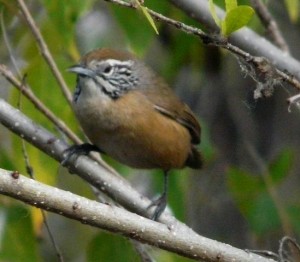
One of the two Navopatia Happy Wrens
north end of the circle. It was not easy to penetrate the thorn forest that surrounded the cottonwoodes but once we did we got clear views of the small lagoon that surprisingly had very few birds. Maybe the best bird of blood letting trip in was a Happy Wren in good but seriously isolated habitat for that species. Another rather lost bird was a Ruby-crowned Kinglet that came into Pygmy Owl tape.
Other finds arond the ond included Gray Flycatcher, Harris's Hawk, Cactus Wren, Rufous-winged Sparrow and a slew of other desert birds.
Then it was off to the coast to pad the list and look for any other interesting shore and waterbirds. The first stop was a location rather central on the count circle and was out the outlet of a small arroyo. It was full of birds. Everything from Spoonbills to Green-winged Teal and even one oddball solo Brant was in the mix.
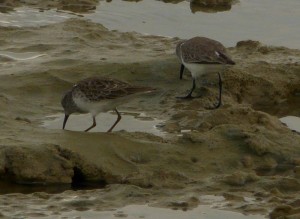
Peeps at La Uva
Our last major stop was at a lagoon called "La Uva" a fantatic spot for shorebirds, waterfoul and Terns. Here we had Gull-billed Terns working their magic not 20 yards in front of us and White-tailed Kites hovering over the feilds in the distance.
The four of us ending up departing after lunch due to commitments back in Alamos, but we did bird our way out of the circle and found a couple of new birds for the count. A hooded Oriole and a Broad-billed Hummingbird.
The final count numbers were lower than past years, coming in at 148 species. Hopefully momentum will grow for this count, as the possibilities for weird birds here are huge, and the amount of interesting and unique habitat is vast.
Thanks again for your participation. If you want to see the final report,




